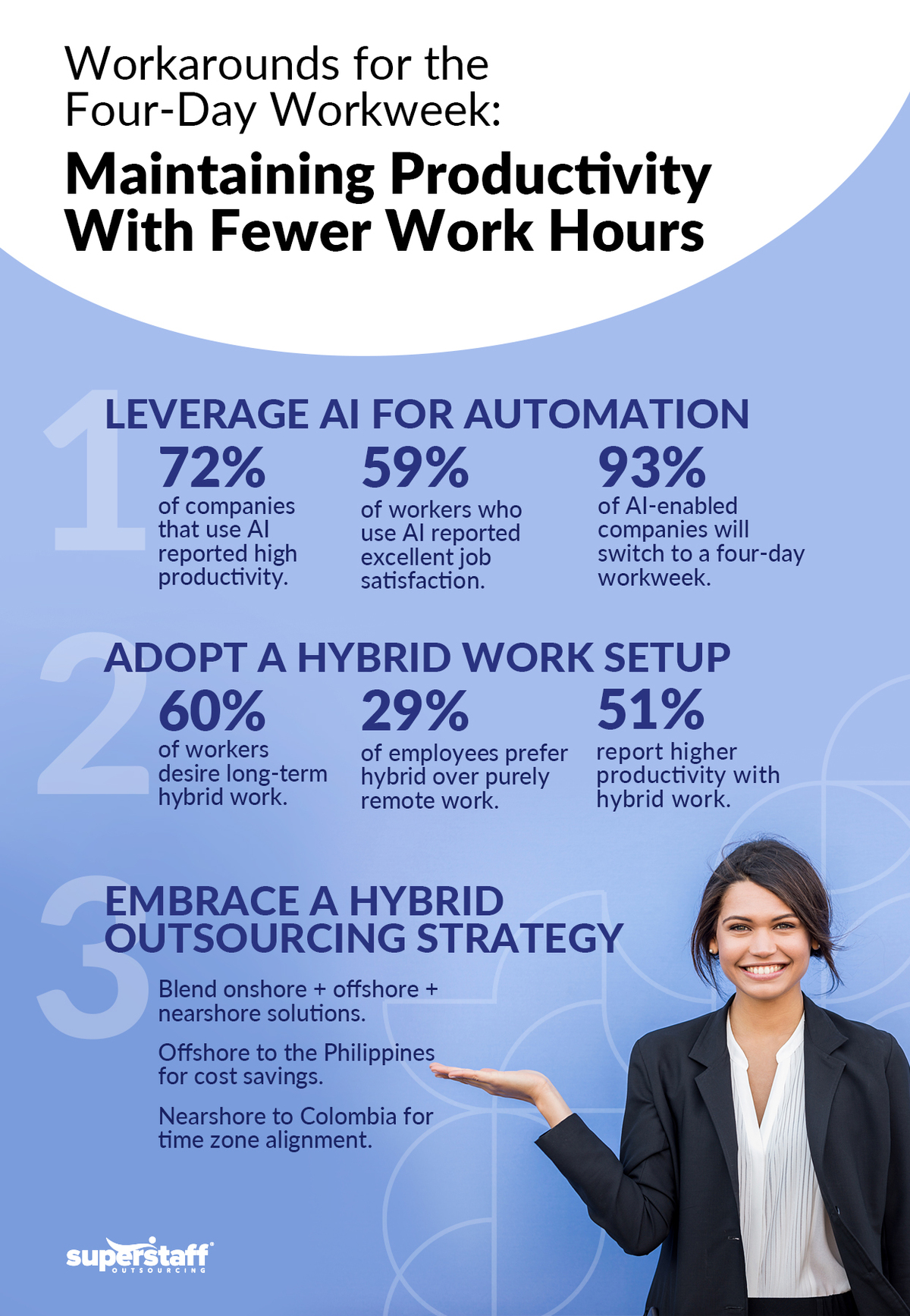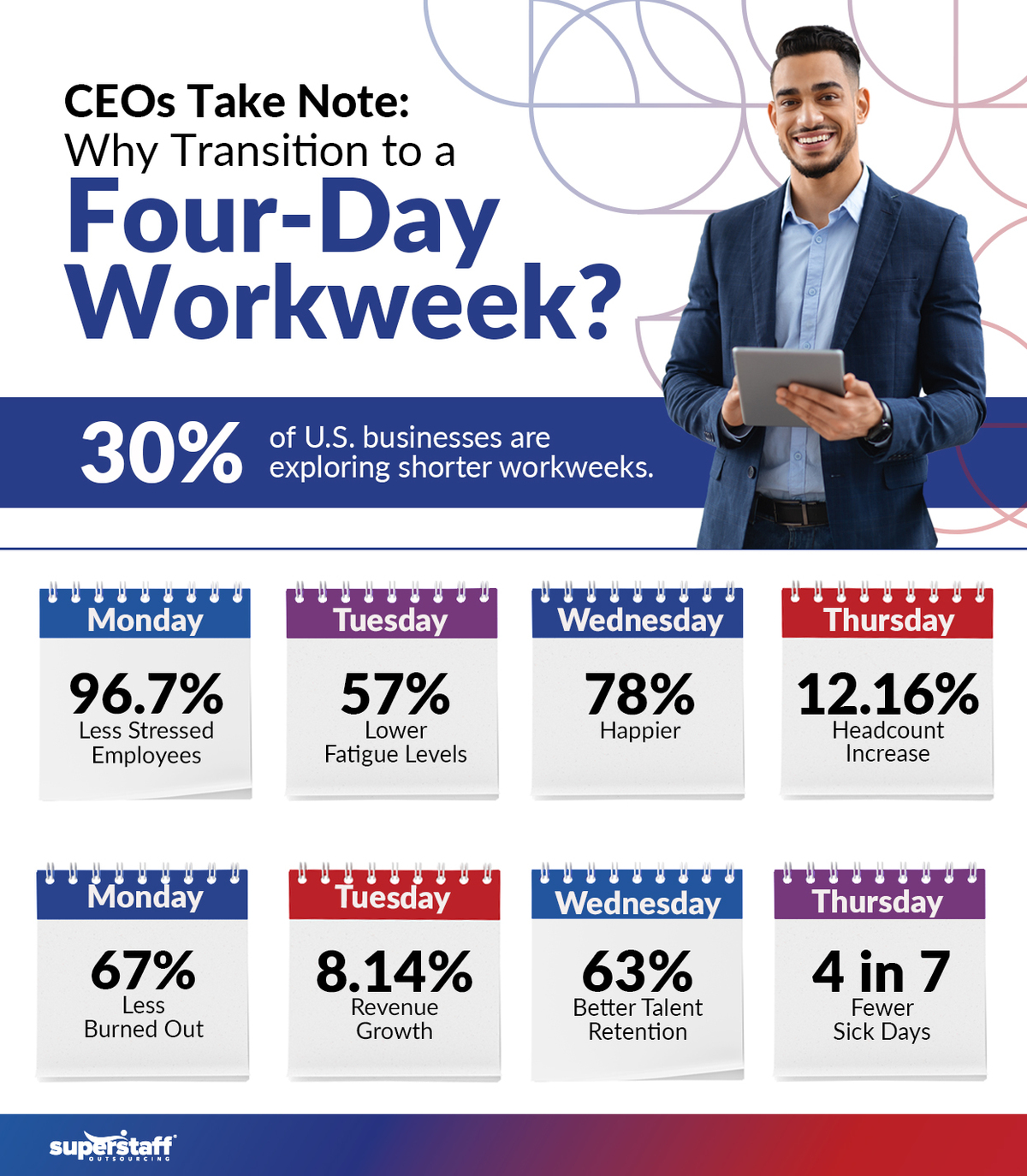
As a CEO, you’re familiar with the Monday through Friday work routine — it’s a habitual part of life, like eating eggs for breakfast or brushing your teeth before bed.
Yet, change is on the horizon. More employees are advocating for schedule flexibility and shorter office hours, challenging the traditional 9-5 norm that’s been in place since the early 20th century. Is the 4-day workweek becoming the new standard for companies in the U.S. and globally? What implications does it hold for employees and businesses alike? And how can you, as an executive, navigate this transition without disrupting your operations?
As a leader, you understand the complexity of managing diverse stakeholder needs. Even if you’re open to change and innovation, implementing shorter work hours requires careful consideration. Balancing productivity with service quality and delivery is paramount.
This article offers insights into navigating the challenges and potential impacts of transitioning to a shorter workweek. We’ll inform you about the latest developments and strategies for adapting to this evolving workplace trend.
Transitioning to a 4-Day Workweek: Is This the Future of the Workplace?
According to KPMG’s 2024 US CEO Outlook Survey, nearly 30% of American businesses are exploring shorter workweeks. You might consider taking a leap of faith by adopting a four-day schedule or perhaps making a smaller step forward with a four-and-a-half-day shift.
You can leverage the shorter workweek to attract and retain top talent amid worker shortages and a tight labor market. With employee engagement at a record low in recent years, you must prioritize initiatives that help your workers achieve greater work-life balance without sacrificing productivity.
Here’s the catch: While you may welcome the chance to improve your employees’ daily work lives, you might still be understandably wary about the four-day workweek’s impact on your operations.
The Workarounds for a 4-Day Workweek: Maintaining Service Quality and Productivity With Fewer Hours
The four-day workweek offers many advantages for both employees and businesses. However, many company leaders like you remain cautious about embracing this emerging trend. For many industries, reducing hours can negatively affect daily operations, leading to project delays, loss of productivity, and lower service quality.
So, if the 32-hour workweek becomes the national standard, how can companies fortify their operations while complying with the reduced work hours?
Embrace the Offshoring + Nearshoring Hybrid Outsourcing Strategy
A hybrid outsourcing approach is a strategy you can use to maintain productivity and efficiency despite the push for a four-day workweek. In today’s unpredictable business environment, putting all your eggs in one basket (or, in this case, one location) can make your operations more vulnerable to disruption. Consider how geopolitical tensions, like the War in Ukraine and the Red Sea Crisis, continue to affect international trade relations and supply chains.
By spreading your operations across multiple locations, you can create a buffer against unforeseen problems, whether it’s a shift in economic and market conditions, changes in government regulations, or even weather disturbances. An outsourcing model that blends onshore, offshore, and nearshore solutions can fortify your business, allowing you to quickly and easily adapt to these disruptions.
Finding the Middle Ground Through Strategic BPO Solutions in the Philippines and Colombia
Whether you agree that the 4-day workweek will become the future national standard or not, you can’t overlook the fact that the modern workplace is quickly changing. Employers must swim with the changing tides to survive or risk getting lost at sea.
If you hope to embrace the shorter workweek but remain wary, strategic outsourcing can help you find an ideal compromise. Partnering with a BPO provider can provide the perfect middle ground: allow your onshore employees to enjoy reduced working hours while fortifying your operations through cost-effective offshore and nearshore solutions.
A Guide to Implementing the 4-Day Workweek: Get the Most Out of Your Outsourcing Strategy
We recommend identifying your core competencies and keeping these operations onshore, leaving you with at least 25% of your workforce in the U.S. For the aspects of your business where geographical distance doesn’t play a crucial role (ideally, 50% of your remaining workforce), delegate these roles to a company that offers outsourcing solutions in the Philippines.
Then, establish the rest of your operations in a nearshore country like Colombia. Your nearshore team can give you a significant cost advantage while working in similar time zones, allowing instant communication and collaboration. This could be particularly beneficial for time-sensitive roles like supply chain and logistics management.
Here are just a few of the advantages your business can acquire by implementing this strategy:
- Significant Cost Savings: Instead of making your core employees work overtime hours, support their daily workload by delegating crucial back-office tasks to an outsourced team.
- Flexibility and Scalability: Even with a 4-day workweek, you can upgrade or downgrade your outsourcing operations to keep up with fluctuating customer demands.
- Competitive Edge: Businesses that outsource to offshore or nearshore providers can maintain (or even increase) their capabilities amid the more assertive push for shortened work hours.
- Reduced Workload: Hiring outsourcing professionals to take on repetitive, time-consuming, or specialized tasks can prevent employee stress, burnout, and fatigue.
- Opportunities for Innovation: Outsourcing allows you to work with diverse teams from across the globe, giving you access to different ideas and perspectives.

Leverage AI for Maximum Productivity
If you’re concerned that a four-day workweek could impact your operational efficiency and productivity, investing in artificial intelligence (AI) can offer a massive advantage. According to a 2024 Impact of Technology Report surveying over 1,000 business leaders, more organizations like yours are utilizing AI to enhance productivity.
Over 72% of companies that use AI extensively reported high organizational productivity, compared to 55% that only use AI in small or limited amounts. These numbers suggest that you shouldn’t just consider embracing AI tools but should find ways to utilize them to their fullest extent.
Here’s the issue: Only 1 in 25 businesses have fully integrated artificial intelligence into their operations. By leading the way in adopting the technology, you can gain a potent competitive edge over your industry peers, maximizing productivity by automating and streamlining key aspects of your business.
What About the Workers?
Leveraging AI is beneficial for organizational productivity and can lighten the workload for many employees. The same study found that 59% of workers who use AI reported excellent job satisfaction. This illustrates that people are willing to embrace new technologies if they can help make their work lives more manageable.
However, not all employees have the skills or knowledge to operate AI tools and software. For AI adoption initiatives to succeed, you must be willing to provide training and upskilling programs for your workers, helping them adapt to innovations and use them for their daily tasks and responsibilities.
So, how can artificial intelligence help your employees become more productive? According to a 2024 Gartner study, 92% of workers want AI to help them handle administrative work, such as researching and summarizing information.
The same research predicted that AI agents will be present at over 25% of virtual and hybrid meetings by 2025, and enterprises will replace 60% of SaaS applications with AI-powered software by 2028.
How Willingness to Embrace AI Affects 4-Day Workweek Programs
According to the 2024 Impact of Technology Report, businesses that use AI in their daily operations are also more open to transitioning to a 32-hour workweek. In fact, most senior executives (93%) in companies where AI tools play a crucial role either plan to adopt this shorter work schedule or have already implemented it.
However, generational differences may affect an executive’s willingness to reduce working hours. Over 65% of millennial and Gen X leaders (aged 35-44) are open to a four-day workweek, compared to only 45% of Baby Boomers (aged 55-64).
Companies that leverage AI for automation can do more work in less time, thus offering reduced working hours for their employees without sacrificing performance and service quality.
Adopt a Hybrid or Flexible Work Setup
Beyond leveraging AI solutions, another strategy for maximizing productivity amid the transition to a four-day workweek is offering your employees hybrid work arrangements. The 2024 Impact of Technology Report found that 64% of businesses offering remote work setups had significantly higher productivity than purely in-office companies.
Why is this the case? One factor is that commuting daily has been shown to contribute to employees’ stress levels, leading to fatigue and burnout, which then translates into lower productivity. Additionally, by providing remote and hybrid work arrangements, you can better utilize technology to streamline and optimize your operations, leveraging video conferencing software, time trackers, and other tools for efficiency and productivity.
Preferred By Employees, Good for Business
If your business struggles to attract and retain quality talent, offering hybrid work arrangements can be the ideal competitive differentiator. According to the 2024 State of Workers report, today’s employees prefer hybrid setups (29%) over fully remote (23%) or fully in-office work.
A Gallup poll echoes these findings, with over 60% of workers desiring long-term hybrid work arrangements. Compared to full-time in-person or remote work setups, hybrid employees feel they have the best of both worlds: greater flexibility and freedom blended with the opportunity to meet, socialize, and collaborate with co-workers face to face.
The top advantages of hybrid work include improved work-life balance (71%), time efficiency (67%), higher productivity (51%), easier coordination with teammates (22%), and improved work relationships (17%).
The Most Pressing Challenges of the 4-Day Workweek
Having outlined the workarounds for navigating potential productivity loss, we’ll now dissect the risks and challenges associated with it. Some disadvantages of reduced work hours include problems with support availability, scaled-down operations, and longer project timelines.
Support Availability Issues
Shorter workweeks can benefit industries or positions where productivity depends on output, and asynchronous communication won’t disrupt or delay operations. However, many jobs, like those in customer service, require people to be present at specific hours to respond to issues and concerns in real time.
One of the most significant downsides of the four-day workweek for your in-house customer service operations is that support may become less available for consumers. Today’s buyers expect to contact a brand anytime, so reducing work hours could present a significant challenge, resulting in potential customer churn.
To illustrate, consider some factors that contribute to a poor customer experience:
- 90% of consumers dislike long wait times when contacting customer service.
- 76% dislike inconsistent messaging across different brand channels.
- 70% don’t want to repeat themselves to multiple agents.
- 40% expect their problem to be resolved in one interaction.
These numbers tell you that customers want support available when needed and on whichever platform they prefer. They get frustrated when they have to repeat themselves or their problem isn’t resolved as soon as possible.
By outsourcing to a call center that offers 24/7 omnichannel customer support, you can ensure that someone will always be available to respond to and resolve your buyers’ most urgent and pressing needs.
Potential Operational Scale-Down
You may need to scale down your operations to stay afloat while keeping salaries at a 40-hour-a-week level. Wages in the U.S. are rising steadily, with the salaries of a typical worker (23%) growing higher than inflation (20%) over the past five years. Although this is good news for workers, it puts many businesses, especially startups and smaller firms, at risk of exhausting their financial resources.
If the four-day workweek becomes the national standard, you must pay employees overtime when they work more than 32 hours a week. However, sectors with constantly fluctuating demands may need to scale down to control the costs associated with higher overtime hours.
Due to insufficient headcount and rising wages, you might struggle to handle peak sales periods. This can impact work delivery and result in lower customer satisfaction. Thankfully, outsourcing services in the Philippines and Colombia can help prevent this problem. Having an offshore or nearshore team allows you to scale up your operations based on customer demand, expanding your capabilities while controlling costs.
Longer Project Timelines
As a CEO, you likely understand that longer work hours don’t always equate to higher productivity. Some roles are output-based, while others’ productivity is measured by the results they deliver for clients.
However, you may also recognize that certain projects require additional hours to meet deadlines. If the 32-hour workweek became the norm, you might feel pressured to increase targets to compensate for reduced hours. Yet, this approach could lead to employee burnout and stress, ultimately affecting work quality.
Consider this alternative strategy: Partnering with a BPO provider can ensure timely project completion. Integrating offshore or nearshore professionals into your team can streamline processes, lighten your workload, and allow you to focus on core competencies.
In Numbers: The Positive Impact of the Four-Day Workweek

Let’s explore the numbers from the latest international trials to help you, as executives, make informed decisions about the growing trend of shorter workweeks. 4 Day Week Global (4DWG), an organization advocating for reduced working hours, has released its research results, which surveyed over 614 employees in countries like the United States, Ireland, New Zealand, and Australia.
In addition to interviewing employees and managers before, during, and after the four-day workweek trial run, the researchers collected monthly data on the companies’ performance. This research aimed to assess the impact of reduced work hours on workers and their respective employers. Here are some of the most compelling figures:
Shorter Workweeks = Happier Employees
According to the study, the 4-day workweek has the most significant impact on your employees’ satisfaction and happiness. Over 78% of workers who participated in the global trial reported feeling happier with their schedules.
The shorter work hours not only enhance your employees’ positive feelings about their jobs but also reduce negative effects on their mental and physical health. Most workers reported feeling less stressed (96.7%) and less burned out (67%) after the trial run. Additionally, your respondents’ fatigue levels dropped from 66% to 57%, and their sleep problems decreased from 59% to 51%.
Generational differences also influence the acceptance of reduced work hours. A recent survey found that 81% of young people (aged 18 to 34) in the US support the four-day workweek and believe it would positively affect a company’s productivity.
Reduced Hours, Increased Profitability
Of course, your employee happiness is only one part of the equation. The same research found that businesses like yours also greatly benefit from the four-day workweek. It makes it easier to keep your employees productive and motivated while improving your bottom line.
Over 63% of companies with a 4-day workweek reported improvements in their ability to attract and retain quality talent. Six out of ten companies that provided data on their headcount were able to increase their staff numbers. Meanwhile, businesses across the board experienced a 12.16% increase in employee numbers throughout the trial run.
Because the headcount grew, overall revenue rose 8.14% during the six-month trial period. Compared to the previous months, revenue across the board increased by 37.55%, and six out of ten companies that reported their monthly revenue saw an improvement in profitability.
Doing More With Less: Impact on Productivity
Perhaps, one of your biggest concerns about the 4-day workweek is whether it will negatively impact your operational efficiency and productivity. However, the same study found that all businesses that tracked organizational and industry-specific productivity metrics and KPIs noticed performance improvements.
Several companies provided performance data records before and during the trial period. Despite the reduced work hours, productivity remained steady compared to previous years. Over the course of the trial, businesses gave overall employee productivity a solid rating of 7.6/10.
Here’s another notable finding: Four out of seven businesses that provided data reported fewer employee sick days, while two noticed significant reductions in their energy use. These numbers show that workers are increasing their productivity by taking fewer emergency leaves and personal days while helping companies reduce utility and energy costs because of the reduced time in the office. They are truly doing more with less.
The Verdict: Is the Four-Day Workweek a “Win-Win” Strategy?
The results of the global trial run showed overall positive outcomes. When asked about their experience and whether they plan to continue with the four-day workweek, nine out of 12 companies say they will definitely keep the reduced work hours, while the remaining quarter desire to continue it but are still cautious about committing to it long-term.
They were also asked to rate their experience on a scale of 0 to 10, with 10 being the most positive. The average rating among all participating companies was 9.2, suggesting they saw the benefits of the shorter workweek firsthand. When asked how the trial run affected company performance, respondents gave an average score of 8.2 out of 10.
Bonus Read:
Four-Day Workweek Adoption All Across the U.S.
As the heated debate on the four-day workweek continues nationwide, some U.S. states are leading the way in embracing this emerging trend. Here are the pioneering states that are advocating for the reduced work hours to become a national standard:
California
In California, the 4-day workweek is being warmly embraced. Of all states nationwide, California’s local government has been among the biggest proponents of this emerging trend. Their congressman, Rep. Mark Takano, passed legislation for reduced work hours as early as July 2021.
Under this progressive bill, the national standard workweek will be shortened to 32 hours from the previous 40. At the same time, employees who work beyond the proposed 32-hour threshold must be compensated under the Fair Labor Standards Act (FLSA).
Massachusetts
Massachusetts is another state pioneering the 4-day workweek in the U.S. In April 2023, representatives Josh Cutler and Dylan Fernandes proposed legislation for a two-year, 32-hour workweek pilot program.
The voluntary program encourages businesses in Massachusetts to reduce their employees’ workweek without reducing pay. In exchange, they receive favorable financial and tax incentives. Rep. Cutler believes the program can help boost worker satisfaction and productivity while helping companies navigate the transition.
Pennsylvania
In Pennsylvania, employees may soon enjoy shorter workweeks under Rep. G. Roni Green’s planned legislation. Her proposed bill aims to reduce work hours without cutting worker pay for companies with more than 500 employees. For now, small businesses won’t need to comply with the legislation. Rep. Green believes giving workers more downtime will allow them to focus on their physical and mental health, leading to a better overall quality of life.
Missouri
Instead of launching the four-day workweek for businesses of all industries, Missouri is starting with the education sector. Research has found that 70% of Missouri teachers seriously consider quitting their jobs or leaving the profession entirely. The high number of resignations led to overstuffed classrooms and increased workloads for those who didn’t go.
To improve teacher retention, Missouri announced a bill to establish a 4-day workweek for one-third of its schools, affecting over 98,000 students. The good news is that this legislation has already attracted qualified teachers, with many schools in the area reaping a significant rise in applications.
Texas
Much like Missouri, Texas has also been adopting the shorter workweek for schools, hoping to aid teacher retention. As of January 2024, around 60 school districts in the state operate on a four-day workweek.
However, the local education sector may soon have to revert to the status quo, with Republican senator Donna Campbell proposing a bill that mandates a return to the five-day week for Texas schools. She argues that the reduced school week affects the quality of education because students have fewer days to learn and receive instructional time. Teacher’s groups in the states continue to oppose and criticize the bill.
Navigate the Transition to a Shorter Workweek With Help From SuperStaff
Are you still debating the pros and cons of the 4-day workweek, or are you already implementing the reduced hours in your company? No matter your present and future plans, SuperStaff can help you bring them to life.
With our vast range of customizable BPO services, we can help you create an outsourcing strategy that works for your specific business needs. Let us be your reliable partner during these times of disruption and uncertainty. We can help you position your brand for global success!






